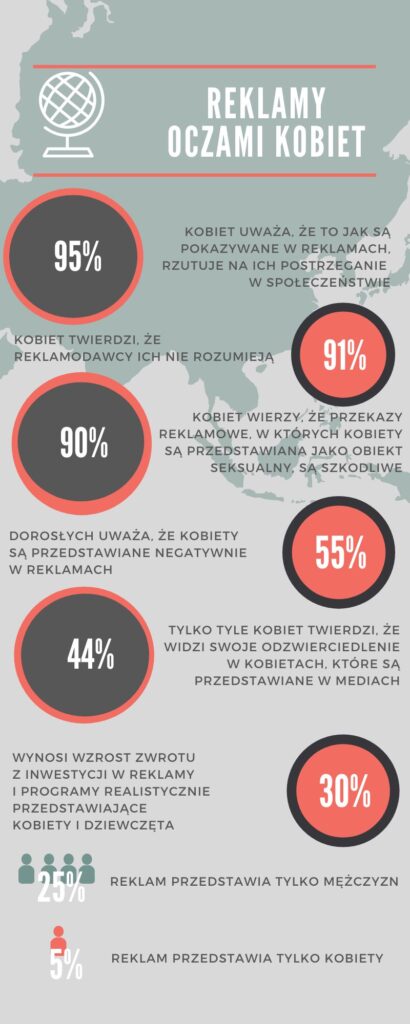Femvertising is the name of the phenomenon of using feminism as a promotion tool. The advertising industry, which once relied heavily on the objectification of women to promote content, has made a 180-degree turn. What for? To attract the attention of female consumers and make them feel "understood and appreciated". Companies are increasingly creating pro-female ads to keep up with trends. However, is it enough to achieve the goal? Let's check.
- Femvertising - definition
- What is femvertising?
- Femvertising - advertising for women through the eyes of women
- Value-based advertising or opportunism?
- The beginnings of femvertising
- Femvertising and communication of Polish brands
- Femvertising around the world - examples
- Examples of activities in Poland
- Femvertising - what are the characteristics of advertising aimed at women?
- How to create advertising messages for women?
- Feminism in marketing - benefits for companies
In the last few years, feminism has changed its face. Instead of being associated with hatred of men, smoking bras and starvation, it is slowly entering the mainstream. Due to the fact that it attracts the attention of a wider and wider audience, femvertising has become convenient a marketing tool.
Femvertising - definition
For several years, women have begun to demand more from the brands whose products they have introduced into their homes, so companies should introduce femvertising into their activities. The definition proposed by SheKnows Media is the most original and the most frequently quoted. She points out that it is "an advertisement that uses pro-female talents, news and images to empower women and girls." Going forward, it is a marketing and communication strategy aimed at inspiring and empowering women while advertising their products and creating interest around the brand.
This is a global trend based on understanding the feminist perspective in a positive sense. Femvertising, or female empower advertising, focuses on the role of women in the modern world, on diversity, gender equality, and evolution. It changes stereotypical thinking and opposes the objectification of women. This term was first defined by the above-mentioned organization SheKnows Media, which since 2015 has been rewarding companies that, according to femvertising, challenge gender norms and create advertisements about pro-female messages and images.
What is femvertising?
Simply put, femvertising is the use of feminist ideals by brands to sell their products or services. Femvertising is about exploring feminist issues, showing female stories, presenting female characters and promoting pro-female messages. However, would brands still deal with women's problems if they did not create this type of advertising? huge promotion opportunities? What if they were not followed by greater recognition, and ultimately - an increase in sales? Probably not. Although some creative directors believe that femvertising is the perfect combination of advertising that can sell goods and empower women at the same time. However, one gets the impression that this hashtag-rich advertising method only exists for one reason. What for? To create positive brand image and build a bond with target group to increase sales.
The real aim of Femvertising should be to raise the bar in portraying women in the media. Initiatives such as the #SeeHer campaign led by the Association of National Advertisers (ANA), the largest marketing and advertising association in the USA, are pursuing this goal. The campaign aims to increase the proportion of women and girls in US advertising and media coverage by 20% by 2020. This marks the 100th anniversary of women's voting rights in the country.
Femvertising - advertising for women through the eyes of women
Many companies continue to create their messages in the belief that family ideals known in the past are important in targeting women today. But this tactic does not suit many, if not most, modern women. Over the past several decades, women have been an underappreciated consumer group. Instead, they have been woven into the rigid roles of cleaners, loyal wives, and beautiful but unintelligent "men's accessories." This inequality was reflected in many hypersexualized advertising campaigns. Example? Reebok, using a slogan a few years ago calling men to cheat on their girlfriends, but not to neglect training - "Cheat on your girlfriend, not on your workout".
Gain the trust of your customers.
Check how we can help you.
Meanwhile, in a SheKnows Femvertising poll, four out of five women found it important for younger generations to watch in commercials positive image of women. In addition, the 71% of female respondents believes that brands should be responsible for the use of messages about women and girls in advertisements.
It's important to remember that storytelling is at the heart of marketing. It is about creating a real connection with your audience. If it's women, it's high time to move away from male-centered marketing tactics based largely on their sexual conquests.
Value-based advertising or opportunism?
Feminism as the belief that women should be treated as equal to men is not just a catchy slogan. It is a way of thinking that fights a relentless and very real struggle for women's equality. This struggle has been going on since the first wave of feminists at the turn of the 20th century. Unfortunately, in the case of marketing, this fight is not always fair. Femvertising, like any other campaign, draws a dangerously thin line between the demonstration of core values and an empty CSR initiative.
Eagerly supporting and promoting the welfare of women can come down to verbal activity on social media. Meanwhile, we should move from words to deeds. If the brand wants to gain trust of your customersshould act in accordance with preached values. Taking a corporate stance in the fight for equal pay can be a nod to the female clientele. However, only the implementation of this will make it the brand will be credible. It is not wise to reap the benefits based on ideals while acting completely against it. Ultimately it can lead to a serious one image crisis.
The beginnings of femvertising
The Dove brand is widely recognized as the pioneer and originator of femvertising. Her iconic True Beauty campaign, one of the greatest in the 21st century, has challenged our culture's obsession with youth, judging women's appearance, and the relationship between self-perception and self-confidence. In this way, Dove became an advocate of positive attitudes and self-esteem for women. It all started in 2004. Following market research showing that only 4% women are considered "beautiful", the Dove brand has started to feature "real" women in its ads. There were representatives of the fair sex of all skin colors, shapes, sizes and ages. One advertisement showed an artist drawing women based on their own descriptions, and then again based on a more favorable description of a complete stranger. The targeted message for women was "You are more beautiful than you think."

Femvertising and communication of Polish brands
An interesting example of femvertising from our home yard is the campaign of one of the door manufacturers. When cars with billboards proclaiming that "women's place is in the kitchen" appeared on the streets of several cities, the network went wild. Subsequent billboards proclaimed that "women are oversensitive about children" or "women talk and talk all the time." Controversial texts turned out to be part of a larger plan.
In the spots, which were an extension of the teasers, there was a summary at the end - the slogan "good!". All these terms were meant to refer to women in a perverse way. The campaign ambassadors - Lara Gessler, Gabi Drzewiecka and Magdalena Różdżka - explained that the features used in the campaign were an advantage in their case. For some they helped in achieving professional success, for others they are useful in everyday life.
Unfortunately, as this example shows, femvertising is a difficult art. There were voices that yes, maybe the intention was good, but in the rush of advertising messages, people are no longer waiting for the teaser phases of the campaign to unfold. There is therefore a fear that the only thing they will remember is disagreement with the message saturated with stereotype. Nevertheless, among many brands, including Polish ones, you can see efforts to avoid duplicating stereotypes that have lingered in advertising for a long time.
Femvertising around the world - examples
Western brands have been using femvertising for years. In addition to the aforementioned Dove campaign, the extremely informative Always #LikeAGirl ad was echoed. The main theme of the spot is the phrase "like a girl", which for some reason has become established in society as a definition that something is worse - eg "you run like a girl" or "you throw like a girl". The ad shows a tremendous contrast between how these words are understood by adults and how they are perceived by children.
Cardstore and American Greetings came up with an interesting alternative, preparing an advertisement showing that femvertising does not have to give up presenting female roles that are considered stereotypical. In the spot, "mother's profession" is presented as the most difficult job in the world, which perfectly reflects the spirit of empowerment (the most important slogan in femvertising).
Other examples of femvertising campaigns include: "Shine like a star" by Pantene, which compared the perceptions of men and women at work, or the advertisement "This girl can", which promoted physical activity, showing that what matters in sport is that derive joy and satisfaction from the practiced discipline, and the body does not have to be "perfect" at all.
The idea of femvertising is not limited to TV spots. A well-planned campaign can make up the bulk of it marketing strategy. This idea was used by, among others the well-known producer of outdoor equipment The North Face in its campaign "She Moves Mountains", which was attended by many famous women practicing extreme sports. The campaign was targeted at those women who do not have the conditions and resources to explore. How did it work in practice? In addition to promotion and graphic advertising, the company focused on cooperation with the charity organization The Outward Bound Trust (an attempt to reduce financial barriers related to off-road sports), as well as cooperation with young women from urban environments (the aim was to show the benefits of outdoor activities). ).
Examples of activities in Poland
An example of activities in the trend of femvertising is the #likes campaign for the cosmetic brand Under Twenty, in which they were involved, among others, Szpura sisters - the owner of the well-known clothing brand Local Heroes. The spot talked about self-confidence, self-acceptance, showed understanding of the target group, presented problems related to puberty. The campaign was continued with the film "I like myself", which drew attention to the problem of self-acceptance among young people. The protagonists of the ad were teenage girls and the influencer Kasia Gandor.
Another campaign talking about women was #MamaMiałaRacji prepared by the Nivea brand. Women who were to tell stories about their mothers were invited to participate in the advertisement. The spot influenced emotions. Its aim was to show mothers as strong, wise women. Moreover, he encouraged them to strengthen ties with their mothers (the brand, among others, organized a competition in which you could win a trip with your mother).
The Agora company came out with an extremely interesting initiative, which, after purchasing the erotic magazine "Twój Weekend", decided to completely change its last edition. Instead of ambiguous photos overloaded with sexist messages, you could find interviews with strong women from various backgrounds and other feminist materials. This historic issue of the magazine symbolically ends the era of objectifying women in newspapers.
Femvertising - what are the characteristics of advertising aimed at women?
Femvertising it ads targeted at women, which does not mean that they are spots promoting typically feminine products. What counts in femvertising is women empowerment, i.e. to equip a woman with attributes such as strength, power or self-confidence - i.e. to strengthen her. The trend emphasizes the power of women and their changing role in society. It responds to their needs. What else do such advertisements characterize?
Their most important feature is that they refute stereotypes. They show that a woman is not only a mother or a wife. First of all, she is ... a woman! A woman who should take care of herself, her comfort and her well-being. It should be open to new - new experiences, possibilities, adventures, opportunities. When watching some ads, you get the impression that the only problems women have are "what to wear", "how to lose weight" or "how to impress a guy". Marketers approach women's problems superficially. Femvertising breaks that. It shows that women are more valuable, they share more important ideas.
Advertising messages in the trend of femvertising pay attention to various nuances - they do not treat women as an object, as a homogeneous group. They show women to the truth - of different ages, from different backgrounds, and with different looks. They don't define one standard definition of beauty. They make them realize that every woman is unique. Femvertising ads can raise difficult issues - such as illness, disability. Their goal is to build and strengthen the belief that there are no barriers for women.
Femvertising draws attention to emotions, and at the same time inspires and motivates. It is based on the assumption that every woman can fight for her dreams and fulfill herself on various levels. He does not need to applaud others. It is self-sufficient and independent. He can achieve a lot, he just has to believe in himself.
How to create advertising messages for women?
Contemporary women take care of their education, they can be financially independent, their role in society is changing. This is undoubtedly worth emphasizing. Show that women can do more.
Gone are the days when women could only be found in commercials of washing powders or cleaning agents - today women are becoming the main protagonists of spots on technology, automotive, banking, etc. Femvertising should become an inseparable element of each brand's strategywhose target group (or part of it) are women. According to research, many people find it harmful to portray women in advertising as sex symbols. Lots of respondents declare that they like messages in the trend of femvertising, because they break gender-related barriers and break stereotypes. A brand that includes femvertising in its marketing messages represents something valuable, is perceived differently by the recipients, and thus has a better chance of success.
How to create a good message in the trend of femvertising? The main thing is to focus on what women want. What do they want?
- Authenticity. Ads should be based on wise, authentic messages. They should not duplicate stereotypes about appearance, interests, goals, or life roles. They should show the true beauty, strength and worth of women.
- Acceptance. Nobody is perfect. You don't have to use Photoshop to show true beauty. Every woman is unique. And that should be the standard. Women want to be accepted. Understanding and respect are essential.
- Forces. Women empowerment is the main slogan of femvertising. Ads should build strength and self-confidence in women. They should show that women can do anything - they can make their dreams come true, pursue their passions, overcome their weaknesses, use their potential. Advertising messages should inspire, motivate to act, show opportunities.
- Understanding diversity. Femvertising negates uniformity. It shows that women want diversity and independence. Builds the belief that age, size, nationality or appearance do not matter. Self-confidence and self-confidence are what counts.

Energy, strength, motivation - these are the elements that should reign in femwertising. In this unique trend, what matters is partnership, dialogue and understanding. It is worth remembering when creating messages addressed to women.
Feminism in marketing - benefits for companies
It seems that stereotyping cannot really be completely avoided. There will always be a smaller or larger campaign based on it. Even now, without any special preparation, you can perform a quick test: do you associate the current laundry advertisement in which the man (excluding Zygmunt Chajzer) is responsible for washing at home and wonders how to wash his son's T-shirt after the match? Rather in vain to look. Meanwhile, according to a panel of industry leaders during Advertising Week in the US, marketing campaigns that empower women and girls rather than perpetuate stereotypes are met with great consumer enthusiasm and are highly effective in generating sales.
So what is especially worth remembering when it comes to femvertising? If carried out skillfully, it gives double the benefits - strengthens the position of women and at the same time generates profits for the brand.

